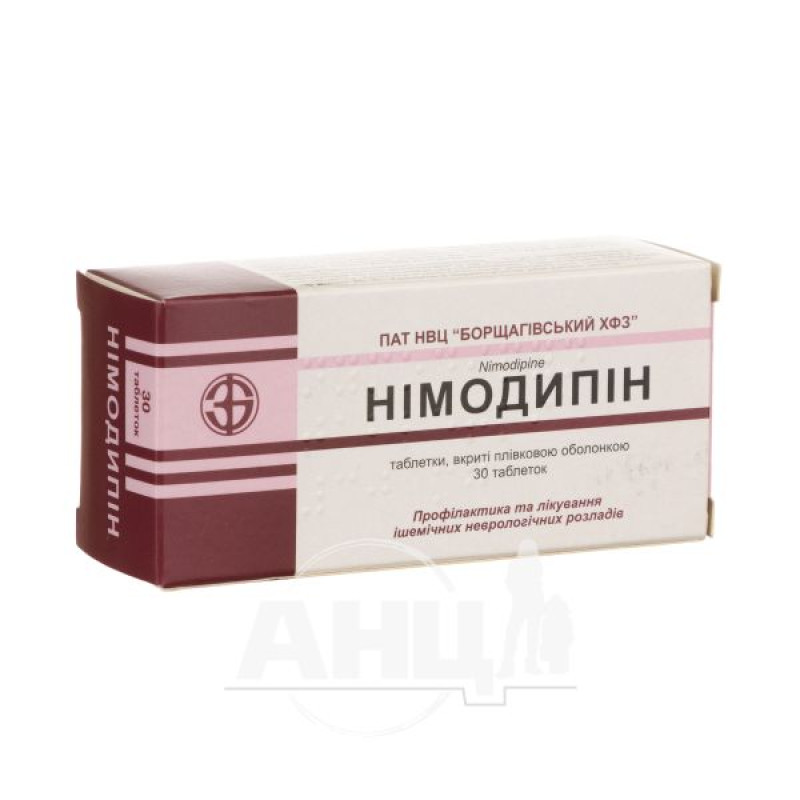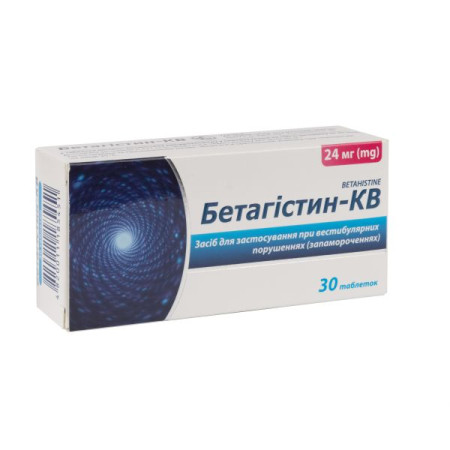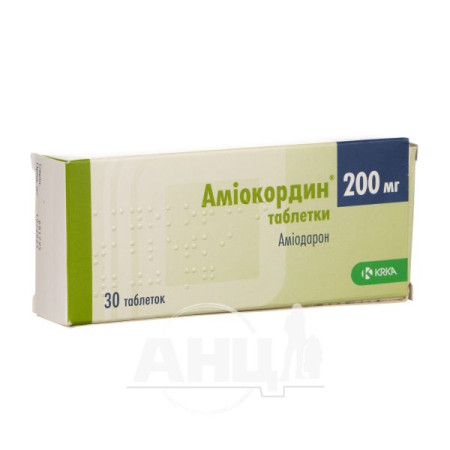Nimodipine film-coated tablets 30 mg No. 30

Pharmacological properties
Pharmacodynamics. Nimodipine is a selective l-type calcium channel blocker, which limits the transmembrane flow of calcium ions. The drug has a vasodilating effect mainly on the vessels of the brain. The antispasmodic effect is due to the effect on the smooth muscles of the vessels. Prevents and eliminates vasospasm caused by the vasoconstrictor effect of serotonin, prostaglandins, histamine. Nimodipine increases perfusion in the affected areas of the brain caused by impaired blood supply, especially after subarachnoid hemorrhages. The therapeutic effect of the drug is manifested in reducing the severity of neurological symptoms caused by brain ischemia. The drug stabilizes the functional state of brain neurons. Nimodipine has a significant effect on systemic blood pressure. Anti-ischemic properties are due to the dilation of coronary vessels.
Pharmacokinetics. When administered orally, 50% of nimodipine is absorbed from the gastrointestinal tract. 10-15 minutes after administration, nimodipine and its metabolites are detected in the blood plasma. C max in the blood plasma is achieved within 1 hour and averages 31 mg/ml. The bioavailability of the drug is low, which is due to intensive metabolism during the first passage through the liver. Nimodipine penetrates well through the blood-brain barrier, the concentration of the drug in the cerebrospinal fluid is about 0.5% of the level of the drug in the blood plasma. Nimodipine may penetrate the placenta and be excreted in breast milk.
The binding of nimodipine to plasma proteins is 97-99%. Nimodipine is excreted in the form of inactive metabolites (50% - by the kidneys, 30% - with bile).
The early T½ of nimodipine is 1-2 hours, and the final one is 8-9 hours.
Indication
Prevention and treatment of ischemic neurological disorders caused by spasm of cerebral vessels after subarachnoid hemorrhage due to aneurysm rupture (prescribed after a previous course of infusion therapy with nimodipine solution); treatment of functional disorders of brain activity in old age with pronounced symptoms (memory impairment, impaired concentration, mood changes).Application
The tablets are taken orally, without chewing, with sufficient liquid 1 hour before or 2 hours after meals.
In case of subarachnoid hemorrhage caused by rupture of an aneurysm after a 14-day course of intensive infusion therapy, it is recommended to take 60 mg (2 tablets) 6 times a day with an interval of at least 4 hours (maximum daily dose - 360 mg) for 7 days with a subsequent dose reduction. The course of therapy is 21 days.
For the treatment of functional disorders of brain activity in the elderly, 30 mg (1 tablet) is prescribed 3 times a day. The duration of use of nimodipine is set individually and can reach several months.
In case of renal or hepatic insufficiency, as well as in case of side effects, it is necessary to reduce the dose of the drug or discontinue treatment depending on the results of monitoring blood pressure, ECG and other functional indicators of the body's condition.
Contraindication
Individual hypersensitivity to nimodipine and other components of the drug; severe liver dysfunction; acute period of myocardial infarction and within 1 month after it; attack of unstable angina; use in combination with rifampicin, with antiepileptic drugs such as phenobarbital, phenytoin, carbamazepine, since the effectiveness of nimodipine is significantly reduced when taken simultaneously with these drugs; pregnancy (except in exceptional cases) and breastfeeding; children and adolescents up to 18 years of age.Side effects
On the part of the gastrointestinal tract: dyspeptic phenomena, diarrhea, nausea, vomiting, gastrointestinal bleeding are possible; rarely - symptoms of intestinal obstruction.
From the hepatobiliary system: rarely - transient increase in the activity of hepatic transaminases, alkaline phosphatase, gammaglutamyltransferase, jaundice, hepatitis.
From the side of the cardiovascular system: a pronounced decrease in blood pressure is possible (especially against the background of an initially elevated level); rarely - increased blood pressure, hot flashes (facial hyperemia, feeling of heat), hyperhidrosis, tachycardia; less often - bradycardia, ricochet vasospasm, deep vein thrombosis, hematomas.
From the respiratory system: stridor, shortness of breath.
From the nervous system: dizziness, weakness, headache, sleep disturbances, psychomotor hyperactivity, aggressiveness, hyperkinesia, depression are possible.
From the blood system: very rarely - thrombocytopenia, anemia, DIC syndrome.
Immune system disorders: acute hypersensitivity reactions, including infrequent allergic reactions, usually mild to moderate (swelling, itching, skin rash).
The risk of developing side effects increases with increasing dose and frequency of drug administration.
Special instructions
The use of nimodipine requires special caution in generalized edema of brain tissue, manifested by increased intracranial pressure, as well as in arterial hypotension with a systolic pressure level of 100 mm Hg.
When treating the elderly, patients with severe renal impairment (glomerular filtration rate 20 ml/min) and severe cardiovascular disease, individual selection of the dose of the drug and systematic monitoring of blood pressure, heart rate, ECG, renal and liver function tests are recommended. If necessary, the dose is reduced or nimodipine is canceled.
Impaired liver function, especially in cirrhosis, may lead to increased bioavailability of nimodipine due to reduced completeness of first-pass metabolism and reduced metabolic clearance. In this case, adverse reactions (e.g. decreased blood pressure) may be more pronounced. In such cases, the dose should be reduced taking into account the level of blood pressure, and if necessary, treatment should be discontinued.
Nimodipine is metabolized by the P450 3A4 system. Drugs that affect this enzyme system may alter the primary metabolism or clearance of nimodipine. Therefore, concomitant therapy should be considered when prescribing nimodipine, taking into account clinically significant drug interactions of this drug.
The simultaneous use of grapefruit juice and nimodipine is not recommended, as it may lead to an increase in the concentration of nimodipine in the blood plasma. This effect may persist for up to 4 days after the last intake of grapefruit juice.
It is advisable to prescribe hepatoprotective agents simultaneously with nimodipine.
Children: There is insufficient experience with the use of nimodipine in children and adolescents under 18 years of age, therefore the drug should not be prescribed to patients in this age group.
Pregnancy and breastfeeding. During pregnancy, nimodipine should be prescribed only in exceptional cases, when the expected benefit to the mother significantly outweighs the potential risk to the fetus. If necessary, use of the drug during breastfeeding, breastfeeding should be discontinued for the period of treatment.
The ability to influence the reaction speed when driving or working with other mechanisms.
Reaction speed when driving or operating other mechanisms may be impaired due to the possibility of dizziness.
Interactions
Nimodipine is metabolized by the p450 3a4 system, located both in the intestinal mucosa and in the liver. Therefore, drugs that affect this enzyme system may alter the primary metabolism or clearance of nimodipine.
The use of nimodipine in combination with inducers of the P450 3A4 system rifampicin and antiepileptic drugs such as phenobarbital, phenytoin or carbamazepine is contraindicated, since the effectiveness of nimodipine is significantly reduced when used simultaneously with these drugs.
Inhibitors of the P450 3A4 system, such as macrolide antibiotics, anti-HIV protease inhibitors (e.g. ritonavir), azole antifungals (e.g. ketoconazole), the antibiotic quinupristin/dalfopristin, and the antidepressant nefazodone, may lead to increased plasma concentrations of nimodipine. Blood pressure should be monitored and the dose of nimodipine reduced if necessary.
Concomitant use of nimodipine and the H2-receptor antagonist cimetidine or valproic acid preparations may lead to an increase in the concentration of nimodipine in the blood plasma and an increase in its hypotensive effect.
Long-term concomitant use of nimodipine and fluoxetine caused an increase in plasma nimodipine concentrations by almost 50%. The effect of fluoxetine was significantly reduced, but the effect of its active metabolite norfluoxetine was not.
Long-term use of nimodipine with the antidepressant nortriptyline leads to a slight increase in the concentration of nimodipine in the blood plasma; the concentration of nortriptyline remains unchanged.
Nimodipine enhances the hypotensive effect of antihypertensive drugs. Simultaneous administration with diuretics, β- or α-blockers or sympatholytics, PDE5 inhibitors and other calcium antagonists leads to increased pharmacological effects. If such a combination is necessary, especially careful monitoring of the patient's condition is required.
With simultaneous use of nimodipine with potentially nephrotoxic drugs (aminoglycosides, cephalosporins, furosemide), potentiation of the negative effect on renal function is possible.
Grapefruit juice inhibits the oxidative metabolism of dihydropyridines. Therefore, the simultaneous use of grapefruit juice and nimodipine is not recommended, as this may lead to an increase in the concentration of nimodipine in the blood plasma.
No drug interaction of nimodipine with haloperidol has been identified in patients taking haloperidol for a long time.
No drug interactions were observed when nimodipine was used simultaneously with such drugs as diazepam, digoxin, glibenclamide, indomethacin, ranitidine, and warfarin.
Animal studies have shown an increase in plasma concentrations of zidovudine when administered concomitantly with nimodipine. The clinical significance of this interaction is unknown, but when co-administering drugs it should be borne in mind that the side effects of zidovudine are dose-dependent.
Overdose
Symptoms: in acute overdose, pronounced hypotension, tachycardia or bradycardia, nausea, functional disorders of the gastrointestinal tract and central nervous system are noted.
It is necessary to stop taking the drug, wash the stomach with the subsequent use of activated charcoal. With severe arterial hypotension, intravenous administration of dopamine or noradrenaline is possible. Hemodialysis is ineffective in case of an overdose of nimodipine.
Storage conditions
In the original packaging at a temperature not exceeding 25 °C.
There are no reviews for this product.
There are no reviews for this product, be the first to leave your review.
No questions about this product, be the first and ask your question.





